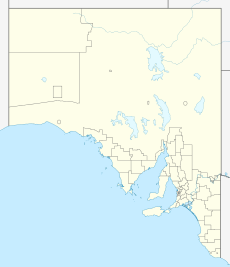Belt Hill Conservation Park facts for kids
Quick facts for kids Belt Hill Conservation ParkSouth Australia |
|
|---|---|
|
IUCN Category III (Natural Monument)
|
|
| Nearest town or city | Hatherleigh |
| Established | 27 April 1972 |
| Area | 10 hectares (25 acres) |
| Managing authorities | Department for Environment and Water |
| See also | Protected areas of South Australia |
Belt Hill Conservation Park is a special protected area in South Australia. It's a place where nature is kept safe. The park is located near the town of Hatherleigh. It's about 317 kilometers (197 miles) south-east of Adelaide, the state capital.
Discover Belt Hill Conservation Park
Belt Hill Conservation Park is a small but important area. It covers about 10 hectares, which is about the size of 10 football fields. This park helps protect local plants and animals. It's a great spot to learn about the natural environment of South Australia.
How the Park Was Created
The land for Belt Hill Conservation Park was once owned by a person named A. McArthur. In 1971, Mr. McArthur offered this land to the National Parks Commission. He wanted it to become a special reserve.
On April 27, 1972, the park was officially created. This happened when a new law called the National Parks and Wildlife Act 1972 came into effect. This law helps protect important natural places across South Australia.
Exploring the Park's Landscape
In 1990, experts described the park's unique landscape. It has a strong sand dune made of calcarenite rock. This dune is covered with sandy soils. On the western side of the dune, there's a low, flat area. This area continues into nearby farmlands.
Plants You Might See
The dune area is home to an "open scrub" type of forest. Here, you can find trees like silver-leaved banksia, blackwood, and golden wattle. The flat, low-lying areas mostly have introduced grasses. However, you can also find some native plants like kangaroo grass and knobby club-rush.
Changes Over Time
Over the years, the park's native plants have been affected. This was mainly due to animals like farm stock and rabbits grazing there. In the early 1950s, a row of pine trees was planted. These trees were put on the southern edge of the park. They helped to stop sand from drifting away.
A Look into the Past
The park also holds clues about its past. In 1990, two old archaeological sites were found on the dune. These sites had small pieces of ancient tools scattered on the surface. Experts believe that many Aboriginal people might have lived here long ago. The area was a good place to live because it was high up, sheltered, and had water. It also offered many sources of food.
There was also an old stone quarry on the southern side of the park. A sand pit was found in the north. Material from these spots was used to build roads by the government.
Protecting Nature
Belt Hill Conservation Park is recognized internationally for its importance. It is classified as an IUCN Category III protected area. This means it's considered a "Natural Monument or Feature." It's a special place that helps protect unique natural features.


